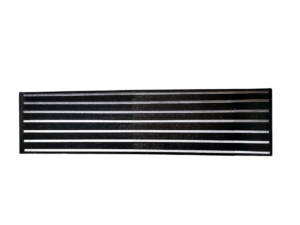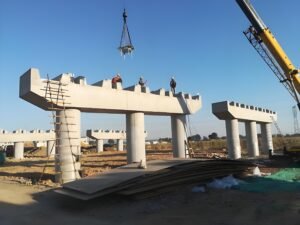Table of Contents
- Introduction
- Innovative Bridge Bearing Technologies for Enhanced Performance
- Bridge Bearing Pad Selection: Factors to Consider
- Elastomeric Bearing Pads: Types, Advantages, and Applications
- Pot Bearings: Design, Installation, and Maintenance
- Spherical Bearings: Benefits, Limitations, and Case Studies
- Q&A
- Conclusion
Bridge Bearings: The Foundation of Structural Stability

Introduction
Bridge bearings are structural components that support the superstructure of a bridge and transfer loads from the superstructure to the substructure. They allow for movement and rotation of the superstructure due to thermal expansion, contraction, and other factors, while maintaining the stability and integrity of the bridge. Bridge bearings play a crucial role in ensuring the safety and longevity of bridges.
Innovative Bridge Bearing Technologies for Enhanced Performance
**bridge bearing: Innovative Technologies for Enhanced Performance**
Bridge bearings play a crucial role in the structural integrity and longevity of bridges. They provide support and allow for movement due to thermal expansion, contraction, and seismic activity. As bridge design and construction evolve, innovative bearing technologies are emerging to enhance bridge performance and extend their service life.
One significant advancement is the use of elastomeric bearings. These bearings consist of layers of rubber and steel plates that provide flexibility and damping properties. Elastomeric bearings effectively absorb vibrations and reduce stress concentrations, leading to improved ride quality and reduced maintenance costs.
Another innovative technology is the introduction of pot bearings. Pot bearings are cylindrical steel containers filled with a high-strength elastomer. They offer high load-carrying capacity and allow for large rotations, making them suitable for bridges with complex geometries or seismic zones.
For bridges subjected to extreme environmental conditions, such as coastal areas or regions with high temperature variations, stainless steel bearings are gaining popularity. Stainless steel bearings resist corrosion and provide excellent durability, ensuring long-term performance even in harsh environments.
In addition to these material advancements, researchers are also exploring new bearing designs to improve bridge performance. For instance, spherical bearings allow for multi-directional movement, reducing stress on the bridge structure and enhancing stability.
Furthermore, the use of sensors and monitoring systems in bridge bearings is becoming increasingly common. These systems provide real-time data on bearing performance, enabling engineers to detect potential issues early on and take proactive maintenance measures.
By embracing these innovative bridge bearing technologies, engineers can design and construct bridges that are more resilient, durable, and cost-effective. These advancements contribute to the safety and longevity of our infrastructure, ensuring that bridges continue to serve as vital transportation links for generations to come.
Bridge Bearing Pad Selection: Factors to Consider
**bridge bearing Pad Selection: Factors to Consider**
Bridge bearings play a crucial role in the structural integrity and longevity of bridges. They provide support and allow for movement between the bridge deck and the substructure, accommodating thermal expansion, contraction, and other forces. Selecting the right bearing pads is essential to ensure the bridge’s performance and safety.
**Load Capacity**
The primary factor to consider is the load capacity of the bearing pads. They must be able to withstand the weight of the bridge deck, traffic, and any other imposed loads. The load capacity should be determined based on the bridge’s design and the expected traffic volume.
**Movement Accommodation**
Bearings must accommodate the movement of the bridge deck due to thermal expansion and contraction. The type of bearing pad selected will depend on the amount of movement required. Elastomeric bearings, for example, provide high flexibility and can accommodate large movements.
**Durability**
Bridge bearings are exposed to harsh environmental conditions, including moisture, temperature fluctuations, and chemicals. They must be durable enough to withstand these conditions and maintain their performance over the bridge’s lifespan. Factors to consider include the material’s resistance to corrosion, weathering, and fatigue.
**Cost**
The cost of bearing pads is another important factor to consider. Different types of bearings have varying costs, and the choice should be made based on the project’s budget and the required performance.
**Installation and Maintenance**
The ease of installation and maintenance should also be taken into account. Some bearings require specialized equipment and expertise for installation, while others can be installed more easily. Additionally, the frequency and cost of maintenance should be considered.
**Other Factors**
In addition to the factors mentioned above, other considerations may include:
* **Seismic performance:** Bearings should be able to withstand seismic forces and minimize damage to the bridge.
* **Noise and vibration:** Some bearings can generate noise and vibration, which should be taken into account for bridges in sensitive areas.
* **Environmental impact:** The materials used in bearing pads should be environmentally friendly and minimize the bridge’s carbon footprint.
By carefully considering these factors, engineers can select the most appropriate bridge bearing pads for their project, ensuring the bridge’s structural integrity, durability, and cost-effectiveness.
Elastomeric Bearing Pads: Types, Advantages, and Applications
**Elastomeric Bearing Pads: Types, Advantages, and Applications**
Elastomeric bearing pads are essential components in bridge construction, providing support and flexibility to bridge structures. These pads are made from a durable elastomeric material, typically natural or synthetic rubber, and are designed to withstand the various loads and movements experienced by bridges.
**Types of Elastomeric Bearing Pads**
There are several types of elastomeric bearing pads, each with its unique characteristics:
* **Plain pads:** These are the simplest type, consisting of a single layer of elastomer. They are suitable for low-load applications.
* **Laminated pads:** These pads are made up of multiple layers of elastomer, with steel or fabric reinforcement. They offer higher load-bearing capacity and flexibility.
* **Reinforced pads:** These pads have steel or fabric reinforcement embedded within the elastomer. They provide exceptional strength and durability.
**Advantages of Elastomeric Bearing Pads**
Elastomeric bearing pads offer numerous advantages over other types of bridge bearings:
* **Flexibility:** They can accommodate bridge movements due to thermal expansion, contraction, and seismic activity.
* **Load-bearing capacity:** They can withstand high loads, including live loads from traffic and dead loads from the bridge structure.
* **Durability:** They are resistant to weathering, ozone, and chemicals, ensuring long-term performance.
* **Low maintenance:** They require minimal maintenance, reducing ongoing costs.
* **Cost-effectiveness:** They are relatively inexpensive compared to other bearing types.
**Applications of Elastomeric Bearing Pads**
Elastomeric bearing pads are widely used in various bridge applications:
* **Highway bridges:** They provide support and flexibility to highway bridges, accommodating traffic loads and thermal movements.
* **Railway bridges:** They are used in railway bridges to absorb vibrations and reduce noise.
* **Pedestrian bridges:** They provide a comfortable and safe walking surface on pedestrian bridges.
* **Seismic isolation:** They can be used in seismic isolation systems to protect bridges from earthquake damage.
**Conclusion**
Elastomeric bearing pads are essential components in bridge construction, providing flexibility, load-bearing capacity, and durability. Their various types and advantages make them suitable for a wide range of bridge applications, ensuring the safety and longevity of these vital structures.
Pot Bearings: Design, Installation, and Maintenance
**Bridge Bearings: Design, Installation, and Maintenance**
Bridge bearings play a crucial role in the structural integrity and longevity of bridges. They provide support and allow for movement between the bridge deck and the substructure, accommodating thermal expansion, contraction, and other forces. Among the various types of bridge bearings, pot bearings stand out for their versatility and reliability.
**Design Considerations**
Pot bearings are designed to withstand a wide range of loads and movements. They consist of a cylindrical steel pot filled with a rubber or elastomeric material. The pot is then encased in a steel housing, which provides additional strength and protection. The rubber or elastomeric material provides flexibility and damping, allowing the bearing to accommodate movement while absorbing vibrations and shock loads.
The design of pot bearings involves careful consideration of factors such as load capacity, movement requirements, and environmental conditions. Engineers must ensure that the bearings can handle the anticipated loads and movements without compromising the safety or performance of the bridge.
**Installation**
Proper installation is essential for the optimal performance of pot bearings. The bearings are typically placed on top of the bridge piers or abutments and secured using bolts or other fasteners. It is crucial to ensure that the bearings are level and aligned correctly to prevent uneven loading and premature failure.
**Maintenance**
Regular maintenance is essential to extend the lifespan of pot bearings and ensure their continued reliability. Maintenance typically involves visual inspections, cleaning, and lubrication. Visual inspections can identify any signs of damage or wear, while cleaning removes dirt and debris that could compromise the bearing’s performance. Lubrication helps to reduce friction and prevent premature aging of the rubber or elastomeric material.
**Advantages of Pot Bearings**
Pot bearings offer several advantages over other types of bridge bearings. They are highly durable and can withstand extreme loads and movements. Their flexibility allows them to accommodate thermal expansion and contraction without causing damage to the bridge structure. Additionally, pot bearings are relatively easy to install and maintain, making them a cost-effective option for bridge construction and maintenance.
**Conclusion**
Pot bearings are an essential component of modern bridge design, providing support and allowing for movement while ensuring the structural integrity and longevity of bridges. Their versatility, reliability, and ease of maintenance make them a preferred choice for engineers and bridge owners alike. By understanding the design, installation, and maintenance requirements of pot bearings, we can ensure the safe and efficient operation of bridges for years to come.
Spherical Bearings: Benefits, Limitations, and Case Studies
**Spherical Bearings: Benefits, Limitations, and Case Studies**
Spherical bearings, a type of bridge bearing, offer unique advantages and limitations in bridge construction. These bearings allow for rotational and translational movement, accommodating structural deformations and thermal expansion.
**Benefits of Spherical Bearings:**
* **Low friction:** Spherical bearings minimize friction between the bridge deck and substructure, reducing wear and tear.
* **High load capacity:** They can withstand significant loads, making them suitable for heavy bridges.
* **Self-aligning:** Spherical bearings automatically adjust to misalignments, ensuring proper load distribution.
* **Corrosion resistance:** Stainless steel or other corrosion-resistant materials are often used to enhance durability.
**Limitations of Spherical Bearings:**
* **Cost:** Spherical bearings can be more expensive than other types of bearings.
* **Maintenance:** They require regular inspection and maintenance to ensure proper functionality.
* **Limited axial capacity:** Spherical bearings have limited axial load capacity, which may require additional support.
**Case Studies:**
* **Golden Gate Bridge:** Spherical bearings were used in the construction of the Golden Gate Bridge, allowing for the bridge’s iconic suspension design.
* **Sydney Harbour Bridge:** Spherical bearings were employed in the Sydney Harbour Bridge, accommodating the bridge’s expansion and contraction due to temperature changes.
* **Akashi Kaikyō Bridge:** The Akashi Kaikyō Bridge, the world’s longest suspension bridge, utilizes spherical bearings to handle the bridge’s massive weight and seismic forces.
**Conclusion:**
Spherical bearings offer significant benefits in bridge construction, including low friction, high load capacity, and self-alignment. However, their cost, maintenance requirements, and limited axial capacity should be considered. Case studies demonstrate the successful application of spherical bearings in iconic bridges worldwide, showcasing their versatility and reliability. By carefully weighing the benefits and limitations, engineers can determine if spherical bearings are the optimal choice for their bridge design.
Q&A
**Question 1:** What is a bridge bearing?
**Answer:** A bridge bearing is a structural component that supports the bridge deck and transfers loads from the deck to the substructure.
**Question 2:** What are the different types of bridge bearings?
**Answer:** Common types of bridge bearings include elastomeric bearings, steel bearings, and pot bearings.
**Question 3:** What is the function of a bridge bearing?
**Answer:** Bridge bearings allow for movement of the bridge deck due to thermal expansion, contraction, and other factors, while maintaining structural integrity.
Question 4:** What are the factors to consider when selecting a bridge bearing?
**Answer:** Factors to consider include load capacity, movement requirements, environmental conditions, and cost.
**Question 5:** How are bridge bearings installed?
**Answer:** Bridge bearings are typically installed by placing them on the substructure and then lowering the bridge deck onto them.
Conclusion
**Conclusion**
Bridge bearings play a crucial role in the structural integrity and performance of bridges. They provide support, transfer loads, and accommodate movements due to thermal expansion, contraction, and seismic activity. The selection and design of appropriate bearings are essential to ensure the safety, durability, and serviceability of bridges.
Modern bridge bearings have evolved significantly, incorporating advanced materials and innovative designs to meet the demands of increasingly complex and challenging bridge structures. They offer improved load-carrying capacity, reduced maintenance requirements, and enhanced seismic resistance.
Ongoing research and development in bridge bearing technology continue to push the boundaries of performance and reliability. By embracing innovative solutions and leveraging advancements in materials science and engineering, engineers can design and construct bridges that are more resilient, sustainable, and efficient.



